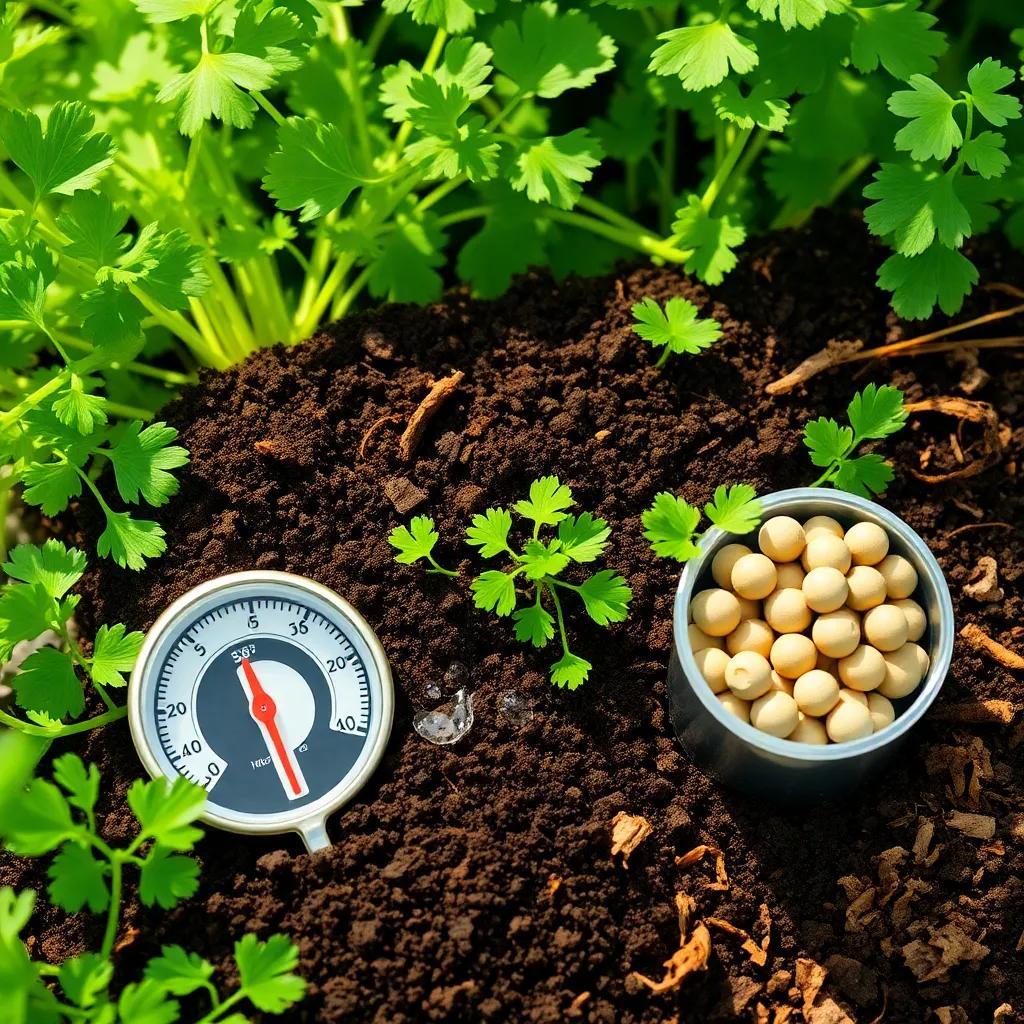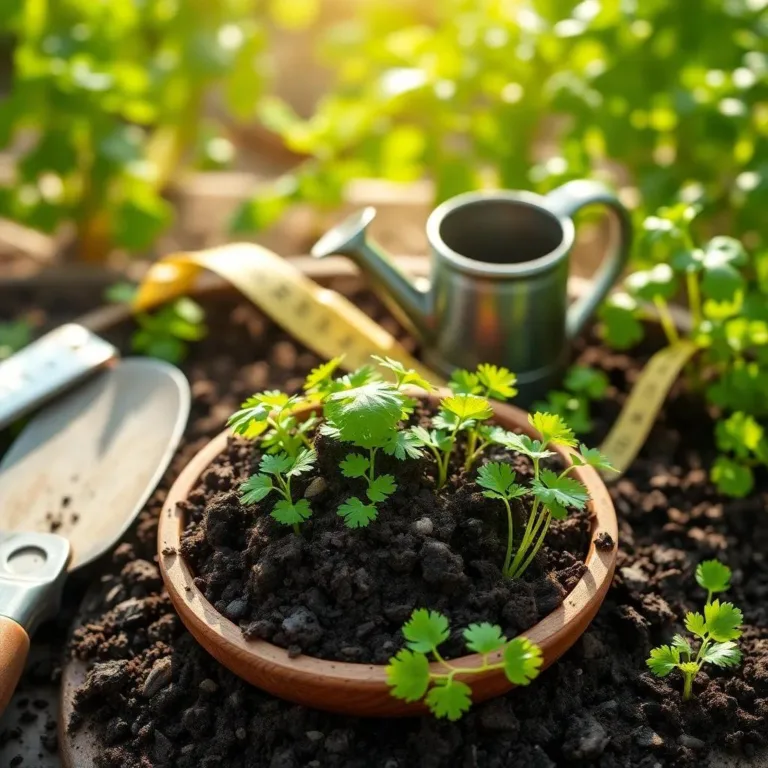Are you ready to grow your own cilantro right at home? I absolutely love this herb, and it’s so easy to cultivate! In this article, I’ll share everything you need to know about how long it takes for cilantro to germinate, the ideal conditions for success, and some handy tips to make your gardening journey a breeze. Let’s dig in and get those herbs growing!
Factors Influencing Cilantro Germination
Growing cilantro can be a fun journey, but certain factors can affect how well those tiny seeds sprout! Let’s take a look at what can influence cilantro germination, so you can maximize your chances of success and enjoy a bountiful harvest!
- Temperature: Cilantro seeds are a bit picky about temperatures. They like it just right! Ideally, aim for a range of 60 to 75°F (15 to 24°C). If it’s too cold, those seeds might take their sweet time. If it’s too hot, they might just give up! Keeping a consistent temperature is key.
- Moisture: Water is essential for germination. But here’s the catch: cilantro seeds love to be kept moist, not soggy! Make sure the soil feels like a damp sponge, but never drenched. Too much water can lead to rotten seeds—yikes!
- Seed Quality: Not all seeds are created equal! It’s best to use fresh cilantro seeds from a reliable source. Old or poorly stored seeds may just sit there and do nothing. So, grab the freshest seeds you can find for the best results!
- Soil Quality: The soil acts like a cozy blanket for the seeds. It should be well-draining, so the seeds don’t drown. A slightly acidic to neutral pH (between 6.0 and 7.0) works wonders for cilantro. Adding some organic matter can make it even better!
- Sowing Depth: Lastly, how deep do you plant those seeds? Aim for about a quarter to half an inch deep. If you plant them too shallow, they might dry out. Too deep, and they’ll struggle to reach the surface. It’s all about finding that sweet spot!
By keeping these factors in mind, you’ll set the stage for successful cilantro germination. Let’s move on to creating the perfect conditions for those little guys to sprout!
Ideal Conditions for Successful Germination
Getting the right conditions for cilantro seeds to germinate is like giving them a warm hug! If you can create an environment where they feel comfy and cozy, you’ll be amazed at how fast they sprout!
Here’s what you need to do:
- Temperature: Aim for a soil temperature between 55 and 68°F (13 to 20°C) for best results. A soil thermometer can help you keep track. Think of it as the seeds’ personal thermostat!
- Moisture: Before planting, make sure the soil is evenly moist. Not too dry, not too wet—just right! It’s like Goldilocks and the Three Bears! Once you plant the seeds, keep the moisture consistent for the best sprouting action.
- Light: Cilantro seeds prefer to keep things dark—yes, they like to party in the shadows! Cover them lightly with soil (about 1/4 inch) to provide the dark they crave. When the seedlings emerge, they’ll need bright, indirect light to grow strong!
- Soil Preparation: Create the perfect mix for your cilantro. Well-draining soil with some organic matter is ideal. You want it to be loose and crumbly. Think of it as the seeds’ cozy bed!
- Planting Depth: Remember to plant cilantro seeds about 1/4 to 1/2 inch deep. This depth ensures they’re snug but can still reach up for moisture and light!
By following these simple steps and taking care of the conditions around your cilantro seeds, you’ll set yourself up for fast and healthy germination. So, roll up those sleeves, prepare the perfect spot, and get ready to watch your cilantro grow! Happy planting!

Expected Timeframe for Cilantro Sprouting
So, you’re excited to grow cilantro and can’t wait for those little sprouts to pop up! Well, let’s talk about the expected timeframe for cilantro sprouting, so you’ll know just when to expect your garden’s new green friends.
Cilantro seeds typically take around 7 to 14 days to germinate under the best conditions. That’s like waiting for pizza delivery—sometimes it feels like forever! But some sprouting can actually happen as fast as 3 to 4 days if everything is perfect. Can you imagine that? Fresh cilantro in less than a week!
Now, keep in mind that the time it takes for cilantro to sprout depends on several factors:
- Temperature: As we mentioned earlier, cilantro loves moderate temperatures between 55 and 68°F (13 to 20°C). If it’s too cold, they might take a little longer. If it’s warm, they could be in a hurry to make their debut!
- Moisture: Consistent moisture is key for speedy sprouting. If the soil is too dry or too wet, your seeds might play hard to get.
- Seed Quality: Fresh, high-quality seeds will sprout faster than older or poorly stored ones. So, always go for the best seeds!
- Soil Conditions: Well-draining soil helps roots establish quickly, which means faster sprouting!
Once your seeds have germinated, you’ll notice small white roots poking through the soil, followed shortly by green shoots. Watching them grow is like waiting for your favorite show to start—exciting and full of anticipation! Remember to give your cilantro the care it needs as it grows, and you’ll be rewarded with delicious herbs to use in your cooking!
Tips for Maximizing Germination Success
Alright, friend! If you want to supercharge your cilantro germination, I’ve got some awesome tips to help you out! These little tricks can make all the difference in your gardening journey, and soon you’ll be the proud parent of lush cilantro plants!
- Start with Fresh Seeds: Always choose fresh cilantro seeds from a reputable source. Fresh seeds are more likely to sprout quickly and successfully!
- Pre-soak the Seeds: Want to give those seeds a head start? Try soaking them in water for 24 hours before planting. This softens the seed coat and can lead to faster germination!
- Planting Depth Matters: Don’t just toss those seeds in! Plant them about 1/4 to 1/2 inch deep. This depth keeps them protected while allowing them to absorb moisture easily.
- Consistent Moisture is Key: Keep that soil evenly moist throughout the germination process. Lightly water it every couple of days to prevent the seeds from drying out.
- Protect from Extreme Conditions: Make sure to shield your seeds from harsh temperatures. If it’s too hot or too cold, those seeds might sulk and refuse to sprout!
- Thin Out Seedlings: Once your cilantro plants emerge, give them some space! Thinning them out helps each plant grow strong without competing for resources.
- Watch for Pests: Keep an eye on your seedlings. Pests can sneak in and ruin your hard work. Use organic methods or physical barriers to keep them at bay!
By following these tips, you’ll boost your chances of growing healthy, thriving cilantro plants. Happy gardening, and may your cilantro be plenty!
Common Issues and Troubleshooting Methods
Sometimes, gardening isn’t all sunshine and rainbows, but don’t worry! I’ve got the scoop on common issues you might face while trying to grow cilantro and how to fix them like a pro!
- Poor Germination: If your seeds aren’t sprouting, double-check the seed quality! Old or poorly stored seeds may not germinate. Also, look at your temperature and moisture levels—are they just right?
- Damping Off: This sneaky fungal disease can attack seedlings and make them wilt. To fight off damping off, make sure there’s good air circulation and don’t overwater! Using sterilized soil can also help.
- Seed Rot: If your seeds are sitting in waterlogged soil, they might start to rot. Always check that your soil is well-draining! If needed, replant in a fresh mix that allows excess water to escape.
- Weak Seedlings: If your plants look leggy or weak, they might not be getting enough light. Move them to a sunnier spot or use artificial grow lights to help them grow strong and healthy!
- Pest Infestations: Watch out for pests like aphids or slugs! A quick inspection can help you catch them early. Try using organic sprays or natural pest control methods to keep your plants safe.
- Overcrowding: If the seedlings are too close together, some will struggle. Thin them out to give each plant space to breathe and grow!
By keeping an eye on these common issues and applying the right solutions, you’ll be well on your way to a successful cilantro garden. Remember, every challenge is a chance to learn and grow! Happy gardening!

